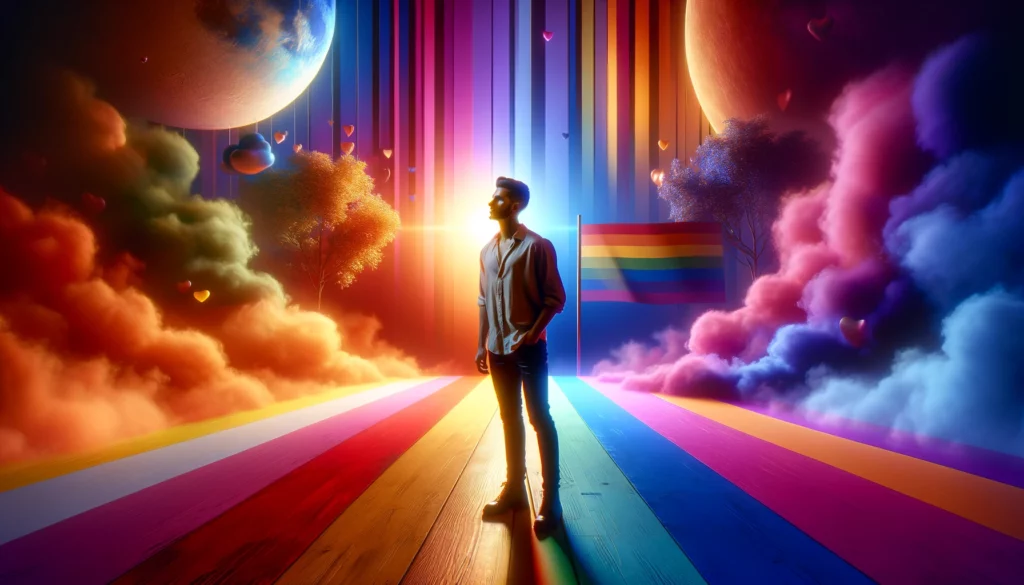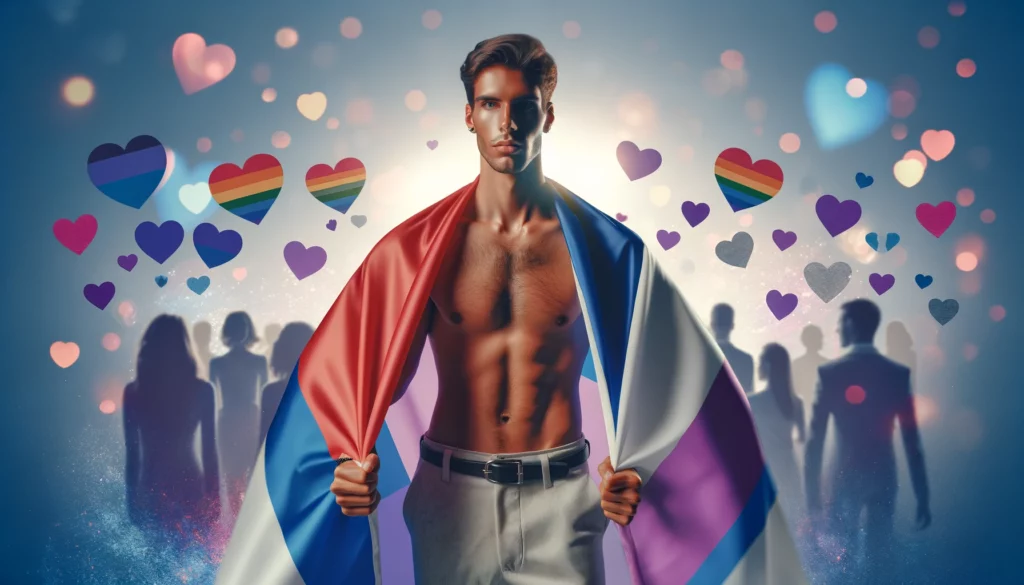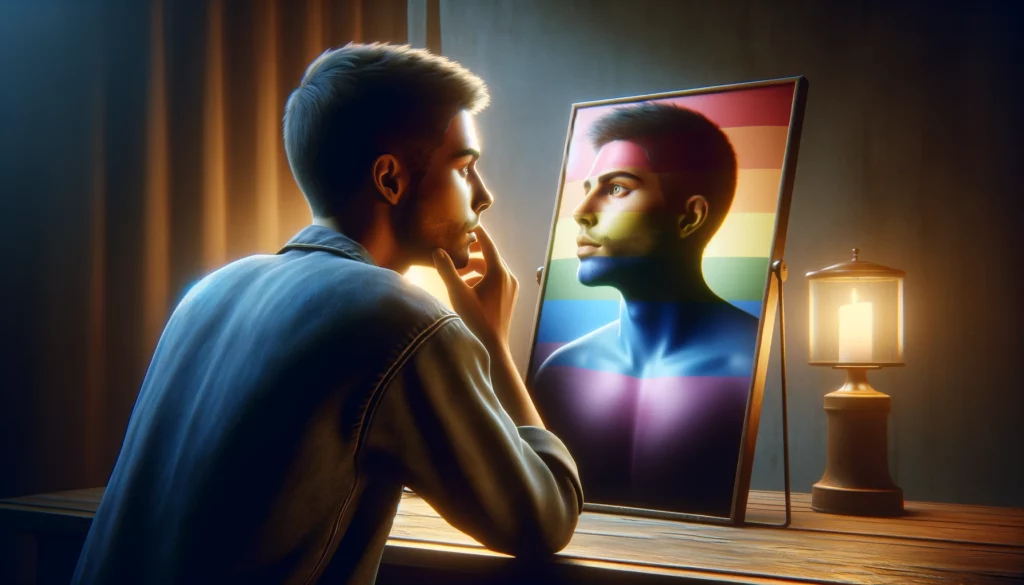Table of Contents

Can a bisexual person have a preference? Introduction
A common myth persists that bisexual people must have equal attraction to men and women. However, having choices and imbalances is a normal part of the bisexual experience. Exploring how desire manifests across the gender spectrum can help bisexual individuals embrace and validate their authentic selves.
Defining bisexual attraction
Bisexuality means someone has the capacity for attraction to more than one gender. It does not necessitate:
- Being attracted to all genders equally.
- Maintaining a perfect 50/50 split between genders.
- Experiencing identical feelings towards men and women.
- Lacking any preferences whatsoever.
The “bi” prefix reflects a potential for multi-gender attraction, not equal attraction.
Why preferences form
A bisexual person’s preferences often reflect their:
Personality – Some bisexual people vibe better with certain genders based on communication styles, shared interests, etc.
Specific tastes – People have types. Particular hair colours, body types, and fashion styles may appeal more strongly across genders.
Social influences – Societal biases and gender socialisation impact how attraction forms from a young age.
Random fluctuations – Hormones, circumstances, and moods create natural fluctuations in desire.
Relationship status – Being partnered can strengthen pulls towards one gender for monogamous bisexuals.
In short, preferences emerge naturally from biology and life experiences. They do not negate bisexual identity.
Degrees of fluidity
Bisexual individuals fall across a spectrum in how fluid or fixed their preferences are:
- Some people remain strongly inclined one way their entire lives.
- Others experience shifts every few years as preferences evolve.
- Some have rapid, short-term fluctuations in desire week to week.
- A minority remains even in attraction ratios long-term.
No pattern is more or less bisexual. The uniqueness makes each person’s sexuality special.
Common preference patterns
While preference patterns are highly individual, some broad themes emerge:
Predominant opposite-gender attraction
- Includes those who identify as heterosexual-leaning bisexuals
- Smaller but still noticeable same-gender desires persist
- Often ignored initially due to societal expectations
Fluctuating preference cycle
- Swings between strongly favouring one gender over the other
- Shifts may align with menstrual cycles for bisexual women
- Phases can last weeks, months, or years
General openness
- Gender factors little in attraction
- Connection with a person’s essence matters more.
- Still, recognising gender isn’t a priority.
The beauty of bisexuality is how it manifests differently for everyone.
Impacts on behaviour
Bisexual individuals’ behaviours may reflect their preferences without invalidating identity:
- A man married to a woman who overwhelmingly favours women may seem straight. But his bisexual feelings still exist.
- A woman sexually active with only women currently identifies as lesbian. But bisexual attraction remains beneath the surface.
- Someone single experiencing opposite-gender attraction pursues those connections for now. Their same-gender appreciation endures.
- An individual with a fixed preference for one gender remains proud to be bisexual. Potential for attraction remains.
Remember, bisexuality is about capacity for attraction, not required action.
Representing preferences
Some individuals choose language reflecting their leanings or fluctuations:
- Heterosexual-leaning bisexual
- Homosexual-leaning bisexual
- Fluid bisexual
- Polysexual
- Omnisexual
- Pansexual
No right or wrong way exists to articulate your unique preferences. Choose whatever resonates.
Preference cycles over time
For those whose preferences fluctuate, patterns may emerge:
During adolescence
- Preferences more evenly distributed or fluid
- Identity often feels blurred or confusing
- Attractions become more channelled with maturity
During adulthood
- Preferences stabilising around mid 20s to 30s
- Cycles lasting months or years emerge
- Identity and self-awareness increases
During midlife and beyond
- Preferences may continue along similar patterns
- Some experience further fluidity as societal expectations lift
- Peace comes from embracing preferences as they evolve
Remember, change is natural. Today’s uneven desires may shift tomorrow.
Honouring both sides
Bisexual people with strong preferences retain parts of themselves drawn to multiple genders.
For men leaning towards women
- Appreciate feminine men despite preferring women
- Recognise strong same-gender bonds platonically
- Feel occasional erotic curiosity about men
For women leaning towards men
- Admire masculine women despite preferring men
- Cherish intimate female friendships
- Feel subtle sexual interest in women sometimes
Every side of you deserves acknowledgement. Suppressing any aspect of your sexuality creates disharmony.
Myths about preference
Misconceptions persist around bisexual preferences. Avoid these harmful notions:
Myth: Uneven attraction makes you less bisexual
Reality: Any capacity for multi-gender desire fits under the bisexual umbrella, regardless of ratios.
Myth: You must have acted on same and opposite-gender attractions to qualify as bisexual
Reality: Bisexuality is about attraction potential, not resume. No proof is required.
Myth: If you have a strong preference for one gender, you should identify as gay/straight
Reality: Bisexuality acknowledges attraction beyond binary options. You get to define your label.
Myth: Your preferences must be fixed life-long to be considered real
Reality: Fluidity is natural. Changing cycles over decades doesn’t invalidate identity.
Healthy mindset around preference
Cultivating self-acceptance lets preferences manifest naturally. Remind yourself:
- Bisexuality manifests uniquely in everyone.
- No shame exists in learning one way. You are whole.
- Keep an open mind as sexuality evolves over a lifetime.
- Diversity of experience strengthens the bisexual community.
- Funnel energy into embracing all parts of yourself.
Tapping into both sides of desire
While a preference for one gender may dominate day-to-day life, letting your whole self thrive means occasionally:
If you lean toward heterosexual
- Acknowledge attraction to those of the same gender mentally, even if not acting on it physically.
- Indulge same-gender romantic fantasies privately.
- Consume LGBTQ+ media to nurture that neglected side.
If you lean toward homosexual
- Recognise opposite gender reverie and appreciation when it emerges.
- Remember former straight crushes fondly rather than suppressing them.
- Allow yourself admiration of conventionally attractive traits in the opposite sex.
Giving all facets of your being space to breathe rejuvenates your spirit.
Freeing sexuality from expectation
Bisexual people often feel pressure to conform to unrealistic standards dictating their attractions. Letting go of these expectations creates freedom.
You are not required to:
- Possess equal or consistent desires for all genders.
- Prove yourself through sexual histories conforming to quotas.
- Actively date every gender frequently to be “enough.”
- Quantify or justify how you locate on the spectrum.
- Alter self-identification whenever preferences naturally shift.
Give yourself unconditional permission to be whoever you are. No rules exist dictating how bisexuality manifests.
Validating your truth
You get to determine if bisexual feels like the right label for your blend of desires and experiences. No preference pattern makes you more or less bisexual. Remind yourself:
- My attractions, though imperfectly balanced, are valid.
- I alone get to determine what identity fits me best.
- Even if I land on a different label someday, I acknowledge the truth of who I am right now.
- Anyone who judges or dismisses my preference pattern lacks compassion.
- I take pride in my unique spectrum of fluid, evolving desires.
You contain multitudes. Let no one else dictate how you should experience or express your bisexuality. Live your truth boldly.
In summary:
Having preferences or imbalances in attraction does not negate bisexual identity. The breadth and depth of the bisexual experience defies simplistic binary notions. Whether desires fluctuate over time or remain more fixed, the full spectrum of attraction bisexual individuals feel deserves equal validation. When you embrace your preferences as an intrinsic part of your identity, not an imperfection, you grant yourself the freedom to thrive as your authentic self. Honour your truth in all its beautifully imperfect complexity.
Understanding Bisexuality
Defining Bisexuality: Bisexuality is a sexual orientation characterised by the potential for attraction—be it romantic, emotional, or sexual—to more than one gender. This attraction does not necessarily have to be equally distributed among all genders.
The Spectrum of Bisexuality: Bisexuality is not a one-size-fits-all experience. It encompasses various potential attraction patterns, varying in intensity, type, and fluidity over time.
The Concept of Preference in Bisexuality
Preference vs. Fluidity: While some bisexual individuals may have a consistent preference for one gender, others experience a more fluid pattern of attraction that can change over time.
Understanding Preferences: Preferences in bisexuality can be influenced by many factors, including personal experiences, emotional connections, and societal influences.
Debunking Myths About Bisexual Preferences
Myth: Bisexuality is 50/50. Attraction: A common misconception is that bisexuality involves equal attraction to multiple genders. In reality, bisexual individuals can experience a wide range of attraction distributions.
Myth: Preference Indicates Inauthenticity: The presence of a preference does not make someone less bisexual. Bisexuality is valid regardless of whether one’s attractions are evenly balanced or lean towards one gender.
Personal Experiences of Bisexual Men with Preferences
Navigating Preferences: Many bisexual men share experiences of navigating their preferences within their bisexual identity, often facing challenges in both heterosexual and LGBTQ+ contexts.
Impact on Relationships: Preferences can influence relationship dynamics. Bisexual men with preferences might find different challenges and joys in relationships with different genders.
The Role of Society and Culture
Societal Influences on Preferences: Societal norms and stereotypes can significantly shape and understand one’s preferences within bisexuality.
Challenging Stereotypes: By challenging societal expectations and stereotypes, bisexual men can gain a clearer understanding of their authentic preferences and attractions.
Bisexuality and the LGBTQ+ Community
Inclusivity within the Community: The LGBTQ+ community’s acceptance and understanding of bisexuality with preferences are crucial for the well-being of bisexual individuals.
Addressing Biphobia and Bi-Erasure: Confronting and educating about biphobia and bi-erasure within and outside the LGBTQ+ community is essential for validating all bisexual experiences.
Exploring Romantic and Sexual Preferences
Differentiating Types of Attraction: Understanding the difference between romantic and sexual attraction can be crucial for bisexual individuals in identifying their preferences.
The Fluidity of Attraction: Recognising that preferences and attractions can be fluid and change over time is an important aspect of bisexual identity.
The Importance of Self-Acceptance
Embracing Individuality: Self-acceptance is key for bisexual men in embracing their preferences, regardless of external expectations or pressures.
Finding Support and Community: Connecting with supportive communities and resources can help bisexual individuals with preferences feel validated and understood.
Bisexual Representation in Media and Culture
The Need for Diverse Representation: Accurate and diverse representation of bisexuality, including the presence of preferences, is crucial in media and culture.
Impact of Representation on Understanding Bisexuality: Positive and nuanced portrayals of bisexuality can lead to a broader understanding and acceptance of diverse bisexual experiences.
Beyond the Binary: Unpacking Bisexuality
Before diving into the complexities of preference, let’s first establish a shared understanding of what bisexuality entails. Bisexuality is a diverse sexual orientation characterised by the potential for romantic or sexual attraction to people of more than one gender. Contrary to popular misconception, it’s not about being “half straight” or “half gay.” It’s a distinct experience encompassing a spectrum of attractions defying binary labels’ confines.
Think of it like a spectrum of light. On one end, you have a pure red light, representing exclusive heterosexuality. On the other end, you have pure blue light, representing exclusive homosexuality. In between lies a vast palette of possibilities, from violet to turquoise to teal, each shade representing a unique blend of red and blue. Bisexuality sits within this spectrum, encompassing a vibrant range of attractions that don’t neatly fit into either extreme.
The Preference Paradox: A Matter of Intensity and Frequency?
Now, back to the question of preference. Can someone who identifies as bisexual lean towards one gender over the other? The answer is absolutely. Just like straight or gay individuals, bisexual people can experience varying degrees of attraction towards different genders. This preference can manifest in different ways:
- Intensity: One gender might ignite a more intense spark, a deeper emotional connection, or a more vital physical magnetism. This doesn’t negate the potential for attraction to the other gender, but it simply means that certain relationships might feel more potent or fulfilling.
- Frequency: You might find yourself more frequently drawn to partners of one gender, either in terms of dating experiences or simply noticing and appreciating physical beauty. This may be due to personal preferences in personality, shared interests, or simply the specific individuals you encounter in your social circles.
However, it’s important to remember that:
- Preference is not exclusive: Having a preference for one gender doesn’t erase the potential for fulfilling and meaningful relationships with the other. Bisexuality is about fluidity and the potential for attraction to blossom regardless of gender.
- Preference can evolve: What you’re drawn to today might not necessarily be what you crave tomorrow. Preferences can change over time, influenced by life experiences, personal growth, and the diverse people we encounter.
Breaking the Mould: Challenging Binary Assumptions
Exploring the complexities of preference within bisexuality challenges several harmful assumptions often associated with this sexual orientation. Here are some of the myths we need to debunk:
- Myth #1: Bisexuality is a “phase” or a stepping stone to another identity. Bisexuality is a valid and legitimate sexual orientation in its own right, not a temporary state on the way to identifying as straight or gay.
- Myth #2: Bisexual people are indecisive or confused. Preference for bisexuality is not a sign of indecisiveness or confusion. It simply reflects the nuanced reality of human attraction, which is never one-dimensional.
- Myth #3: Bisexual people can’t be monogamous. Bisexuality has no bearing on one’s capacity for committed relationships. Bisexual individuals can be just as happy and fulfilled in monogamous partnerships as anyone else.
Embracing the Spectrum: Understanding and Respecting Bisexual Experiences
As we move towards a more inclusive and understanding society, appreciating the complexities of bisexuality is crucial. Here are some key takeaways:
- Bisexuality is a diverse and multifaceted sexual orientation.
- Having a preference for bisexuality is perfectly normal and doesn’t negate the validity of the identity.
- Preferences can be fluid and evolve.
- Bisexual individuals deserve respect and understanding, just like anyone else.
By acknowledging the spectrum of experiences within bisexuality, we can break down harmful stereotypes and create a more accepting space for everyone to navigate their journey of self-discovery. Remember, understanding the complexities of human attraction, in all its diverse forms, is a journey best undertaken with openness, compassion and respect.
Conclusion
Bisexuality is a complex and diverse sexual orientation, and having a preference for one gender over another is a valid part of many bisexual individuals’ experiences. Understanding and accepting these preferences is crucial for the personal well-being of bisexual individuals and for broader societal acceptance. Through education, open dialogue, and inclusive representation, we can foster a more understanding and supportive environment for all expressions of bisexuality.
Explore More on BisexualMen.uk

For those who wish to delve deeper into the world of bisexual and bicurious men in the UK, BisexualMen.uk offers a comprehensive and welcoming online portal. This platform provides more than just information; it’s a gateway to vibrant communities, unique experiences, and safe spaces for exploration and connection. Discover a variety of established businesses and events tailored for bisexual men, from luxurious saunas to intimate cinema clubs. Embrace your journey of self-discovery and community connection by visiting BisexualMen.uk.
FAQ
Can preferences change over time for bisexual individuals?
Yes, bisexual preferences can evolve and shift throughout one’s life. This fluidity of attraction is a normal part of bisexual identity for many people.
Is having a strong preference towards one gender common among bisexuals?
Many bisexual people do have a predominant preference toward one gender. However, preferences exist on a spectrum, so this experience varies individually.
Can I identify as bisexual if I’ve only had relationships with one gender?
Absolutely. Bisexual identity is defined by attraction, not actions. You do not need sexual experience with multiple genders to identify as bisexual.
Do all bisexual people experience attraction cycles?
No, fluid cycles of preference are common but not universal. Some bisexual people experience fairly fixed preferences over time rather than shifts.
Does acknowledging my preferences mean denying part of my bisexuality?
Not at all. Your preferences are a valid part of your complex bisexual identity. Embracing them helps you understand and honour the full spectrum of your attractions.



